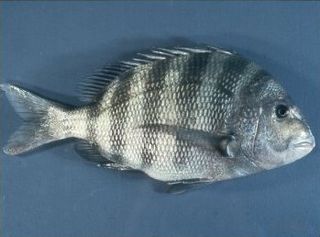
Archosargus probatocephalus, the sheepshead, sheepshead seabream or convict fish, is a species of marine ray-finned fish belonging to the family Sparidae, the seabreams and porgies. This species is found in the Western Atlantic Ocean. The sheepshead is an important species to recreational and commercial fisheries.

Sparidae is a family of ray-finned fishes belonging to the order Spariformes, the sea breams and porgies, although they were traditionally classified in the order Perciformes. They are found in shallow temperate and tropical waters around the world and are demersal carnivores.

The red porgy, or common seabream, is a species of marine ray-finned fish in the family Sparidae. It is found in shallow waters on either side of the Atlantic Ocean, being present on the western coast of Europe and the Mediterranean Sea as well as the eastern coasts of North and South America and the Caribbean Sea. It feeds on or near the seabed and most individuals start life as females and later change sex to males.

The common dentex is a species of marine ray-finned fish belonging to the family Sparidae, which includes the seabreams and porgies. This species is found in the northeastern Atlantic Ocean and the Mediterranean Sea. It is a highly valued food fish and is an important target species for fisheries and the population has shown large declines leading the International Union for Conservation of Nature to classify its conservation status as Vulnerable.
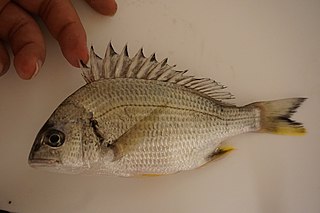
Acanthopagrus latus, the yellowfin seabream, grey bream, Houttuyn's yellowfin seabream, Japanese bream or yellow-finned black porgy, is a species of marine ray-finned fish belonging to the family Sparidae, the seabreams and porgies. This fish is found in the Western Pacific Ocean.
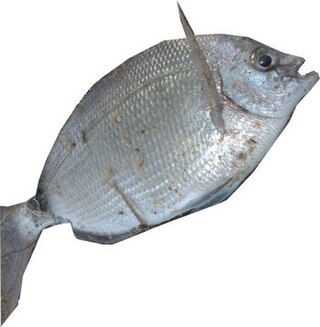
The spottail pinfish is an ocean-going species of fish in the family Sparidae. It is also known as the Spottail seabream. Along with other members of their family, Spottail pinfish are occasionally eaten and considered by some to be a panfish.

Western Atlantic seabream is an ocean-going species of fish in the family, Sparidae. It was first described in 1758 by the "father of modern taxonomy," Carl Linnaeus, in the 10th edition of his book, Systema Naturae. Within their native range, Western Atlantic seabream are also known as the seabream, brim, tropical sheepshead, chopa amarilla, or salema. Although they are eaten, and have been described as pan fish, Western Atlantic seabream have not gained the popularity as a gamefish that their relative, the sheepshead has.

The pluma porgy, also known as the West Indian porgy, pluma or pimento grunt, is a species of marine ray-finned fish belonging to the family Sparidae, the seabreams and porgies. This species is found in the Western Atlantic Ocean.

Boops is a genus of marine ray-finned fishes belonging to the family Sparidae, the seabreams and porgies. There are two species in this genus, one in the Western Atlantic and Mediterranean, and the other in the Western Indian Ocean.

The sargo or white seabream is a species of seabream native to the eastern Atlantic and western Indian Oceans. It is found from the Bay of Biscay southwards to South Africa, including Madeira and the Canary Islands, the Mediterranean and (rarely) the Black Sea. Occasionally individuals are found off the Indian Ocean coasts of South Africa, Mozambique and Madagascar, and they are very rarely found elsewhere in the Indian Ocean, such as off Oman. An active fish, they inhabit the surf zone, but they may be found down to 50 m.

Diplodus is a genus of marine ray-finned fish belonging the family Sparidae, a family containing the seabreams and porgies. These fishes are found in the Atlantic Ocean, the Mediterranean Sea and the western Indian Ocean.

Archosargus is a genus of marine ray-finned fishes belonging to the family Sparidae, the sea breams and porgies. These fishes occur in the Western Atlantic and Eastern Pacific Oceans.
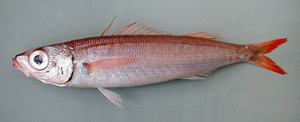
Centracanthus cirrus, the 'curled picarel, is a species of marine ray-finned fish belonging to the family Sparidae, the seabreams and porgies. This fish is found in the temperate Eastern Atlantic Ocean and the Mediterranean and Black Seas. It is the only extant species in the genus Centracanthus. This species is of minor importance to commercial fisheries.

Centracanthus is a genus of marine ray-finned fishes belonging to the family Sparidae, the seabreams and porgies. There is a single extant species in this genus, as well as an extinct species classified within the genus. The extant species is found in the eastern Atlantic Ocean, the Mediterranean Sea and Black Sea.

Diplodus vulgaris, the common two-banded sea bream, is a species of seabream belonging to the family Sparidae.

Diplodus cervinus, the zebra sea bream, is a species of marine ray-finned fish belonging to the family Sparidae, which includes the seabreams and porgies. This species is found in the temperate north eastern Atlantic Ocean and the Mediterranean Sea.

Dentex is a genus of marine ray-finned fishes belonging to the family Sparidae, which includes the seabreams and porgies. The fishes in this genus are found in the eastern Atlantic Ocean and the eastern Indian and Western Pacific Oceans.
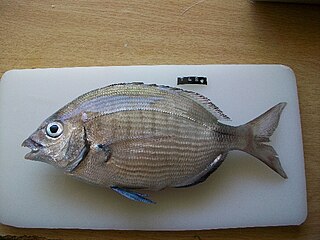
Diplodus capensis, the Cape white seabream or blacktail seabream, is a species of marine ray-finned fish belonging to the family Sparidae, which includes the seabreams and porgies. This fish is found around the coasts of Southern Africa.

Acanthopagrus bifasciatus, the twobar seabream, is a species of marine ray-finned fish belonging to the family Sparidae, the sea breams and porgies. This species is found in the northwestern Indian Ocean.
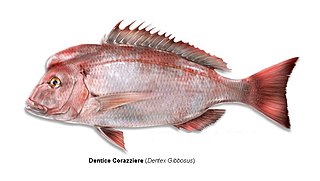
The pink dentex is a species of marine ray-finned fish belonging to the family Sparidae, a family that includes the seabreams and porgies. This species is found in the temperate and tropical waters of the eastern Atlantic Ocean and the Mediterranean Sea.



















